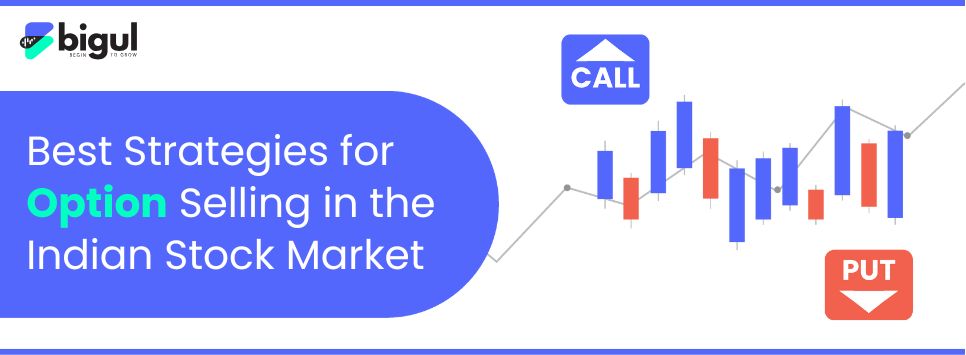In the rapidly changing Indian shares market, option trading has become a worthwhile tactic for both individual and institutional traders. Though start-ups usually initiate by purchasing options because of the minimal risk involved, seasoned traders favour option selling — a technique yielding regular returns by way of collection of premium along with increased odds of success.
One of the major benefits in time decay, loosening volatility, or range-bound price for any seller are the selling of calls or putting them down. This method largely helps in India, where indices like Nifty and Bank Nifty often trade within anticipated ranges and enjoy better liquidity. From the buyer's perspective, high price fluctuations are welcomed, whereas option sellers prosper when prices just hold on.
That being said, this strategy is risky in trend or volatile conditions, so risk management and selection of the strategy become essential. In fact, based on the right kind of strategies, traders could technically implement "structured set-ups" like credit spreads, straddles, or iron condors to control risk whilst maximizing profits.
This article reveals the best option selling strategies in India, designed for various outlooks in the market — bullish, bearish, and neutral — to guide you in trading wisely, maintaining capital, and creating stable returns.
Also Read | 5 Option Strategies Every Investor Should Know
What is Option Selling?
Option selling, or selling options, as it is also called, means selling call or put contracts to receive a premium. In a hope to allowing the options to expire worthless for profit. Traders selling call options usually expect the market to either drop or remain stable, while those selling puts generally hope for steady or rising prices.
Buyers' only risk is the premium, whereas sellers' risks are higher with limited returns, mainly in intense market moves against them. To limit risk, many traders employ strategies such as covered calls, cash-secured puts, or credit spreads. Option selling is best for stable or range-bound markets and works best with liquid instruments such as Nifty, Bank Nifty, and large-cap stocks.
Every Trader Must Know These Best Option Selling Strategies
Option selling strategies differ based on market sentiment — bullish, bearish, or neutral — and are designed to earn income, control risk, or speculate. Some of the important ones are:
· Covered Call: Selling a call on stock that is already owned in order to collect premiums; effective in sideways or slightly bullish markets.
· Cash-Secured Put: You sell a put on a stock you are willing to buy at less than market price. You can also short the stock if the stock is less than what you think it would sell at; moderately bullish outlook.
· Iron Condor: Combines call and put spreads to leverage range-bound markets with limited risk.
· Credit Spreads:
o Bull Put Spread: Sell ATM put, buy lower-strike put (bullish).
o Bear Call Spread: An at-the-money (ATM) call is sold and a higher strike call is bought, expecting the stock to decline.
· Butterfly Spread: Take advantage of low volatility by using long and short calls or puts at three strike prices.
· Short Straddle: Sell a call and a put at the same strike, making money from little movement.
· Naked Option Selling (Risky): Sell calls or puts without covering; can result in unlimited loss and suits experts only.
Bullish Option Selling Techniques
Bullish techniques are applied when you anticipate prices going up moderately or remaining
horizontal:
· Cash-Secured Put: Get premium by committing to purchase the stock if it declines; suitable for conservative bullish expectations.
· Bull Put Spread: This is an option selling strategy employed when the underlying instrument is likely to remain above the sold strike price, where a put is written at an upper strike and one is purchased at a lower strike to cap potential losses and receive a premium..
· Covered Call: You own the stock while selling calls to create income; good if you expect flat or low to modest stock price growth.
· Synthetic Call: Long stock + long put is a long call; unlimited gain for a single premium, and some downside or depreciation though little to none.
· Put Ratio Spread: Sell more puts than bought for net credit; works in very bullish markets but increases risk of loss on the downside.
· Bull Call Spread: Sell high-strike call and buy low-strike call; limited risk and reward, best suited for managed upside.
Bearish Option Selling Trading Strategies
Bearish strategies are most suitable when traders anticipate a fall or stability with a downside bias in stock prices. While limiting risk, these help to profit from falling prices.
· Covered Put: Sell put and short stock. Risk is there, if the stock moves upward, although premiums and the stock price tend to decline.
o Best for: When there is a strong negative outlook on the stock.
o Risk/Reward: Risk is limited, while the reward comprises the premium received and gains from the stock’s decline.
o Bear Call Spread: Involves selling a call at a lower strike and buying another at a higher strike, with the expectation of profiting if the underlying stays below the lower strike price..
o Best for: Mildly bearish markets.
o Risk/Reward: The loss is limited, while the profit, at best, will be the net premium received.
· Naked Call: In this plan, a call option is written with no short position in the underlying stock, exposing the trader to the risk of potentially unlimited loss.
Huge reward if price is flat or falls, but risky if price goes up.
o Best for: Aggressive bearish bias.
o Risk/Reward: Unlimited risk; limited reward (premium).
· Bear Put Spread: You can buy a put that has a higher strike and you can sell a put that has a lower strike. Why you win: The stock falls moderately with minimal loss.
o Best for: Bearish moves.
o Reward: Limited to the difference in the strike prices minus the premium; risk can be the deduction.
· Call Ratio Spread: Sell more calls than purchased, hoping stock to remain below upper strike.
o Ideal for: Range-bound bearish outlook.
o Risk/Reward: Greater risk if price goes up too much with a capped premium reward.
· Short Straddle: Sell ATM call and put. Makes money from little movement.
o Ideal for: Slightly bearish or neutral opinion.
o Risk/Reward: Unlimited risk is present in either direction, with premium received being the reward.
· Synthetic Put: Sell the stock and buy a call. Allows limited risk with a synthetic long put position.
o Best suited for: Controlled bearish expectation.
o Risk/Reward: Risk is limited to the premium paid and profits can be earned if the price drops.
Neutral Option Selling Trading Strategies
Neutral option selling trading strategies generate income when the market isn’t moving quickly and stays in narrow ranges. Neutral option selling is better suited for a neutral or non-trending range-bound market.
· Iron Condor
Description:
With the addition of long calls and a bear call spread along with long puts and a bull put spread, an established price range is supposed to be profitable.
Suitable for: Range-bound markets
Risk/Reward: Limited both ways; your net premium is your gain.
· Short Straddle
Description:
Short ATM calls and puts. Maximum profit is reached if the stock stays around the strike price; expectations of a narrow range and no movement.
Risk/Reward: While the net premium is retained, potential loss is unlimited if the underlying moves significantly.
· Short Strangle
Description:
Short OTM call and put. Better protection than a straddle.
Suitable for: Mild market outlook with a wide trading range
Risk becomes unlimited if the price crosses past the breakeven points, while the maximum reward is less than in a straddle.
· Butterfly Spread
Description:
Calls and puts are bought and sold at three strike prices, with a gain realized if the stock is at the middle strike.
Best suited for: Stable price environments
Risk/Reward: Low cost and risk involved, with returns also being limited.
· Calendar Spread
Description:
An option is sold in the near term and an option is purchased in the long term at the same strike price. It benefits from time decay.
Best suited for: Stable prices with increasing volatility
Risk/Reward: Returns are dictated by time decay and volatility movement; risk is limited to the net premium.
· Iron Butterfly
Description:
Sell an at-the-money (ATM) call and put, and cover with out-of-the-money (OTM) options.
Best suited for: Low-volatility sideways markets
Risk/Reward: Highest return is equal to the net premium received; risk is limited between the range of the chosen strike prices.
Is Option Selling Profitable in the Indian Stock Market?
Yes, option selling can be profitable in India for disciplined traders who apply proper risk management. Products like Nifty and Bank Nifty are very liquid and ideal for premium-selling strategies.
Why It Works:
● High Win Rate: Options often expire worthless, giving sellers an edge in flat or low-volatility markets.
● Premium Income: Upfront premiums offer stable long-term returns.
● Strategic Flexibility: Works in bullish, bearish, or neutral markets.
● Stable Returns: Well-managed trades like credit spreads can yield 7–12% per annum.
Key Risks to Manage:
● Unlimited Loss Potential: Especially in naked selling; should be avoided or properly hedged.
● Capital Requirement: Higher margins required (₹1–1.4 lakh/lot); lower capital liquidity.
● Risk Management Need: Proper use of stop-losses, position sizing, and hedging is essential.
Desirable Profitable Strategies:
● Covered Call: Sell a call option on shares you already own to earn premium income
● Cash-Secured Put: Sell puts on stocks you'd like to own at lower prices.
● Iron Condor: Combine selling out-of-the-money calls and puts with protective options to have a limited risk profit in a sideways market.
● Short Straddle: Sell both call and put to collect double premiums — carries high directional risk.
To Remain Profitable:
● Follow the Market: Track trends, volatility, and indicators.
● Risk First, Profit Second: Use hedged setups like spreads to cap losses.
● Be Patient and Persistent: Avoid emotional trades; discipline and long-term vision are key
Conclusion
Option selling is a tactical method to earn steady income in Indian markets. Whether bullish, bearish, or neutral — there’s a strategy for every viewpoint, from covered calls to iron condors. Its strength lies in profiting when the market does little. However, it carries risk — especially naked selling, which can cause large losses in sudden moves. That’s why risk-defined strategies and active management are crucial.
Also Read | 5 Effective Stock Options Strategies to Manage Risk

.jpg)






.jpg)
.jpg)
